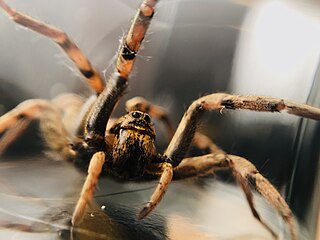
Wolf spiders are members of the family Lycosidae, so named for their robust and agile hunting skills and excellent eyesight. They live mostly in solitude, hunt alone, and usually do not spin webs. Some are opportunistic hunters, pouncing upon prey as they find it or chasing it over short distances; others wait for passing prey in or near the mouth of a burrow.

Huntsman spiders, members of the family Sparassidae, are known by this name because of their speed and mode of hunting. They are also called giant crab spiders because of their size and appearance. Larger species sometimes are referred to as wood spiders, because of their preference for woody places. In southern Africa the genus Palystes are known as rain spiders or lizard-eating spiders. Commonly, they are confused with baboon spiders from the Mygalomorphae infraorder, which are not closely related.
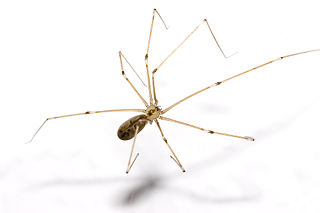
The Pholcidae are a family of araneomorph spiders. The family contains more than 1,800 individual species of pholcids, including those commonly known as cellar spider, daddy long-legs spider, carpenter spider, daddy long-legger, vibrating spider, gyrating spider, long daddy, skull spider, and angel spider. The family, first described by Carl Ludwig Koch in 1850, is divided into 94 genera.

Velvet spiders are a small group of spiders almost entirely limited to the Old World, with the exception of one species known from Brazil. In Europe, some are commonly called the ladybird spiders.
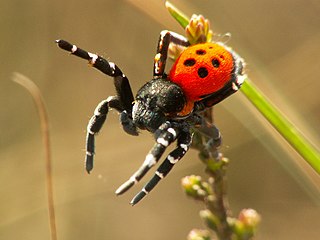
Sexual selection in spiders shows how sexual selection explains the evolution of phenotypic traits in spiders. Male spiders have many complex courtship rituals and have to avoid being eaten by the females, with the males of most species surviving only a few matings and consequently having short life-spans.
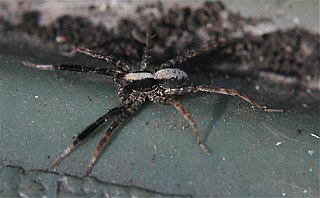
Schizocosa is a genus of wolf spiders containing around 60 species, distributed in North and South America, Africa, and East and Southeast Asia.

Alireza Zamani is an Iranian arachnologist and taxonomist.
Schizocosa saltatrix is a species of wolf spider in the family Lycosidae. It is found in North America.
Schizocosa retrorsa is a species of wolf spider in the family Lycosidae. It is found in the United States and Mexico.
Schizocosa bilineata is a species of wolf spider in the family Lycosidae. It is found in the United States and Canada.

Schizocosa crassipes is a species of wolf spider in the family Lycosidae. It is found in the United States.
Ogcodes borealis is a species of small-headed flies. Hosts include spiders of the genus Pardosa as well as the species Schizocosa rovneri.

Schizocosa avida is a species of wolf spider in the family Lycosidae. It is found in North America.
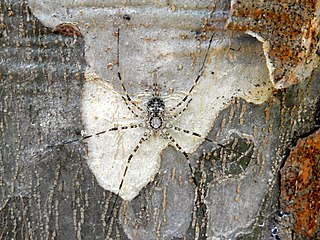
Neotama mexicana, also known as the long-spinneret spider or Mexican two-tailed spider, is a species of tree trunk spider in the family Hersiliidae. It is found in a range from the United States to Peru and Guyana.
Schizocosa minnesotensis is a species of wolf spider in the family Lycosidae. It is found in the United States and Canada.
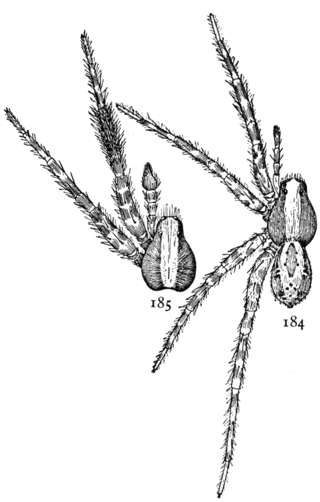
Schizocosa ocreata is a species of wolf spider in the family Lycosidae that is found in North America. The Schizocosa ocreata is a spider that is most commonly known as the “brush-legged wolf spider” because of their distinct dark-colored fur-like coverings around their legs. The S. ocreata are commonly found in North American states, usually in the middle and eastern United States.

Schizocosa mccooki is a species of wolf spider in the family Lycosidae. They can be found from the west coast to western Lake Erie in western North America, including Canada, the United States, and Mexico.
Schizocosa stridulans is a sibling species of S. ocreata and S. rovneri and is part of the wolf spider family. The name of the genus comes from the epigynum structure being lycosid and having a split T excavation. This spider is well-known for its specific leg ornamentation and courtship rituals and that is how it has been differentiated from its related species. The S. stridulans take systematic steps during its courtship ritual, which involves two independent signals. More specifically, female spiders will leave silk and pheromones to communicate that they are ready to mate.
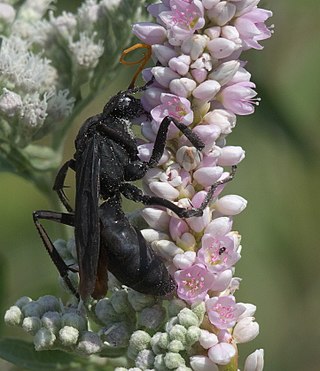
Entypus fulvicornis is a species of spider wasp belonging to the family Pompilidae. It is found in North America.
Schizocosa rovneri is a species of wolf spider found in the United States. Its habitat is primarily leaf litter along floodplains.











